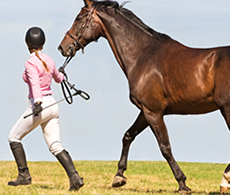
How to spot equine lameness
It’s not always easy to recognise when your horse is lame, especially if the signs are subtle. Our experts show you what signs and symptoms to look out for, and discuss what causes lameness and how it can be treated.
Lameness is anything that causes an abnormality of gait or an asymmetry of the gait. It is often related to pain within the horse’s limb, or elsewhere in the musculoskeletal system, but you can also get mechanical lameness where there is an abnormality of gait but not necessarily pain.
What causes horse lameness?
Lameness can occur in both front and hind limbs, and there’s a huge variety of causes. Injuries to the hoof, such as abscesses in the hoof from an infection and bruised soles from standing on a hard object such as a stone, can make a horse suddenly quite lame, as can soft-tissue injuries like ruptured tendons and fractured bones.
Some cases of lameness aren’t as obvious at first and gradually get worse, such as orthopaedic-type lameness caused by wear and tear on the joints, tendons or ligaments.
Lameness in horses is often associated with certain disciplines due to the repetitive nature of the work. For example, racehorses often suffer superficial digital flexor tendon injuries from overstraining tendons while galloping at full stretch. In dressage horses, we see proximal suspensory desmitis in the hindlimbs from the high level of collection work required. Stifle lameness is common in showjumpers who might frequently hit their stifles on jumps.
Signs and symptoms of lameness in horses
One of the most common ways to spot lameness is the ‘head nod’ as seen in horses with unilateral (one) front-limb lameness. This is when the horse raises its head as the lame limb hits the floor and then lowers it again when the non-lame leg lands. The idea is that the horse lifts the weight of their head off the lame leg when that limb is weight bearing.
You might also see a shortening of the stride in the lame leg, or if both legs are lame, you’ll see a shuffling action. The range of flexion in the joints of a lame leg may be reduced, too, and some horses will drag the toes of the lame hind leg.
Hindlimb lameness is sometimes trickier to see than forelimb lameness. In severe hindlimb lameness, you might still see a head nod where the horse takes the weight forward when the lame hind leg is weight bearing. But the most obvious feature is the point of the hip moving up and down a lot more on the lame side as the horse attempts to take weight off the lame leg.
Sometimes horses will ‘plait’ the lame leg, which is where they swing the limb outward and then back in, so they don't have to flex the joints so much.
Horses can also be lame in both legs, which is called bilateral lameness. If mild, bilateral lameness can be difficult to spot, and signs might include a reduction in performance and change in behaviour, with the horse becoming grumpier and unwilling to work. If it is severe, the horse won't want to move, so it is easy to see.
Other behavioural signs associated with lameness include a horse swishing their tail, putting their ears back and staring with their eyes, which are all expressions of pain. Subtle loss of performance should be noted, too, because some horses are stoic and might not react as aggressively as others. More obvious signs of extreme discomfort associated with lameness include bolting, rearing and bucking.
In this video, Petplan Equine veterinary experts Gil Riley and Juliette Edmonds explain how you can assess your horse and recognise subtle signs of lameness.
How to diagnose lameness in a horse
When diagnosing lameness, vets follow a specific protocol to gain as much information as possible...
- To begin, the vet will take a full history of the horse including previous injury, what’s happened and what’s changed, as well as the owner’s ambitions for the horse.
- The vet will then assess the horse’s conformation (how they are put together), looking at areas that might be swollen or asymmetrical.
- An assistant will then walk and trot the horse up and back in a straight line so the vet can watch them move, and then their legs are flexed (held in a flexed position for a period of time before being asked to trot on immediately). Flexing the limb puts the joints under pressure and can exacerbate any pain originating from them.
- The horse is then lunged on both a firm and a soft surface.
- Once the vet has a better idea where the lameness might be coming from, they will look more closely and palpate the area to look for further signs.
Diagnosing the lameness in more detail requires the use of certain equipment. The first port of call is usually nerve blocking, where the vet injects local anaesthetic into an area to numb it.
If the horse moves better, the vet can be more confident that the lameness is coming from that region. They can then follow that up with imaging such as X-rays, ultrasound and MRI scans (all of which are covered under Petplan Equine's veterinary fee benefit), to find out exactly what has happened.
Watch this video with Simon Joyner, veterinary surgeon with Western Counties Equine Hospital, for great advice on spotting lame strides.
Treatment and prevention of lameness in horses
Treatment depends on the injury or reason behind the horse's lameness. Rest and controlled exercise make up a big part of the initial treatment of an injury, the length of which depends on the type of injury.
For ongoing joint problems, either arthritis, cartilage or ligament injury, corticosteroid injections are usually the most useful and affordable. There’s also stem cell treatment, platelet-rich plasma (PRP) and polyacrylamide gel, which stimulate the healing process in soft-tissue injuries as well as joints.
If the injury involves fractures or bone chips, surgery is often required to either fix a break or remove bone fragments.
Carefully managing a horse with a previous injury or ongoing condition such as arthritis will help prevent further damage and maintain soundness for longer.
For horses with wear-and-tear-related conditions, changing their work routine to add in variety can help, alongside using therapeutic exercise such as swimming and water treadmills.
Alongside lameness investigation and medication costs, your Petplan Equine insurance may cover some alternative therapies for conditions such as those mentioned above.
Horses should only be worked in accordance to their current level of fitness, and it’s important to ride sensibly on a variety of different surfaces and avoid too much repetitive work. Correct hoof balance is important, as is maintaining a correct weight for the individual horse to prevent excessive strain on joints and soft tissue.
Has your horse ever been lame or had a lameness work-up by a vet? Share your experiences and find out how others have coped with their horse’s lameness on Facebook.
Do you think we’re doing a good job? If you do, please vote for us in this year’s Insurance Choice Awards. Plus, you’ll also be entered into a prize draw to win £1,000 (Ts&Cs apply)




